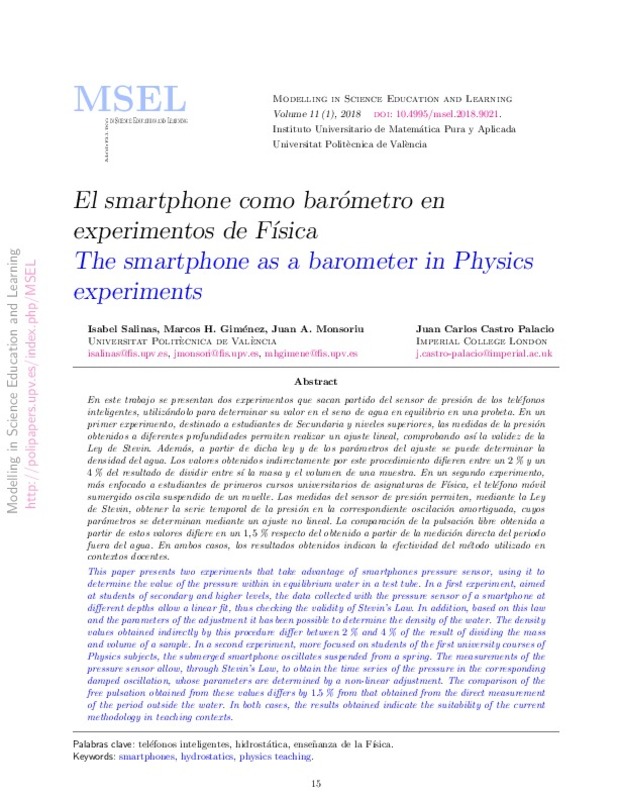|
Resumen:
|
[EN] This paper presents two experiments that take advantage of smartphones pressure sensor, using it to determine the value of the pressure within in equilibrium water in a test tube. In a first experiment, aimed at ...[+]
[EN] This paper presents two experiments that take advantage of smartphones pressure sensor, using it to determine the value of the pressure within in equilibrium water in a test tube. In a first experiment, aimed at students of secondary and higher levels, the data collected with the pressure sensor of a smartphone at different depths allow a linear fit, thus checking the validity of Stevin's Law. In addition, based on this law and the parameters of the adjustment it has been possible to determine the density of the water. The density values obtained indirectly by this procedure differ between 2% and 4% of the result of dividing the mass and volume of a sample. In a second experiment, more focused on students of the first university courses of Physics subjects, the submerged smartphone oscillates suspended from a spring. The measurements of the pressure sensor allow, through Stevin's Law, to obtain the time series of the pressure in the corresponding damped oscillation, whose parameters are determined by a non-linear adjustment. The comparison of the free pulsation obtained from these values differs by 1.5% from that obtained from the direct measurement of the period outside the water. In both cases, the results obtained indicate the suitability of the current methodology in teaching contexts.
[-]
[ES] En este trabajo se presentan dos experimentos que sacan partido del sensor de presión de los teléfonos inteligentes, utilizándolo para determinar su valor en el seno de agua en equilibrio en una probeta. En un primer ...[+]
[ES] En este trabajo se presentan dos experimentos que sacan partido del sensor de presión de los teléfonos inteligentes, utilizándolo para determinar su valor en el seno de agua en equilibrio en una probeta. En un primer experimento, destinado a estudiantes de Secundaria y niveles superiores, las medidas de la presión obtenidos a diferentes profundidades permiten realizar un ajuste lineal, comprobando así la validez de la Ley de Stevin. Además, a partir de dicha ley y de los parámetros del ajuste se puede determinar la densidad del agua. Los valores obtenidos indirectamente por este procedimiento difieren entre un 2% y un 4% del resultado de dividir entre sí la masa y el volumen de una muestra. En un segundo experimento, más enfocado a estudiantes de primeros cursos universitarios de asignaturas de Física, el teléfono móvil sumergido oscila suspendido de un muelle. Las medidas del sensor de presión permiten, mediante la Ley de Stevin, obtener la serie temporal de la presión en la correspondiente oscilación amortiguada, cuyos parámetros se determinan mediante un ajuste no lineal. La comparación de la pulsación libre obtenida a partir de estos valores difiere en un1,5% respecto del obtenido a partir de la medición directa del periodo fuera del agua. En ambos casos, los resultados obtenidos indican la efectividad del método utilizado en contextos docentes.
[-]
|









